Downloads
Executable for the map editor (Windows 32bits)
Executable for the game (Windows 32bits)
Before you try to compile the code go to the "Projects" tab on the left menu, select the "Run" settings for your kit,
and set the "Working directory" to the path of "editor\data" for the editor or "game\data" for the game.
Multilines texts
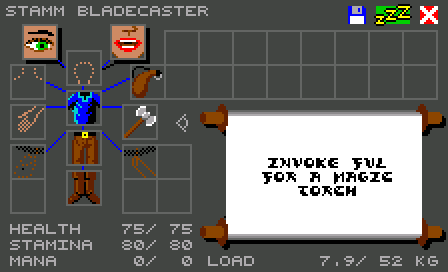
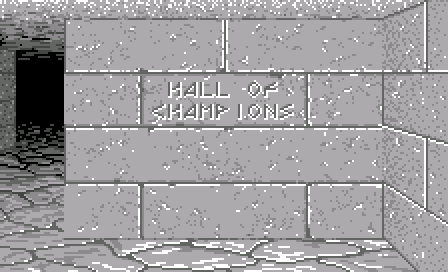
These texts are special. When they are displayed, they are split into several lines.
At first I thought I would use a width parameter and split the text when it is larger than this width using a word-
wrapping algorithm.
But I changed my mind when I saw this text in an emulator:
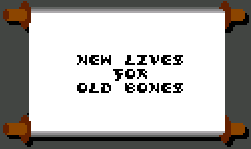
Here we can see that in the original game, they did not use an algorithm to limit the width of the text.
If they did so, the second line of the text would at least contain "FOR OLD" because it is shorter than the first line.
They must have inserted line breaks by hand in the source text.
So that's what I did. I chose to use the "_" character as a line break and here are what the texts of the 2 scrolls in the
first level look like:
<text id="SCROLL00">INVOKE FUL_FOR A MAGIC_TORCH</text>
<text id="SCROLL01">NEW LIVES_FOR_OLD BONES</text>
std::vector<std::string> CInterface::getTextLines(std::string text)
{
std::vector<std::string> lines;
size_t start = 0;
size_t end = 0;
while (true)
{
end = text.find('_', start);
if (end != std::string::npos)
{
lines.push_back(text.substr(start, end - start));
start = end + 1;
}
else
{
lines.push_back(text.substr(start, end));
break;
}
}
return lines;
}
Before writing a function to display that strings vector, I wanted to clean up a little bit the drawText() function.
until now, it used an "8" value which denoted the width of the characters in the font image. I replaced this value
by a define "CHAR_WIDTH".
It also used a strange variable called "offset" which was substracted from CHAR_WIDTH to get the spacing between 2 characters
on the screen. I replaced it by a function.
So here is the "cleaned up code":
//------------------------------------------------------------
int CInterface::getCharSpacing(EFonts font)
{
if (font == eFontStandard)
return 6;
else if (font == eFontScroll)
return 6;
else
return 8;
}
//------------------------------------------------------------
#define CHAR_WIDTH 8
void CInterface::drawText(QImage* image, CVec2 pos, EFonts font, const char* text, QColor color)
{
[...]
int spacing = getCharSpacing(font);
[...]
int i = 0;
while (text[i] != 0)
{
int c = codes[text[i] - 32];
CRect rect(CVec2(c * CHAR_WIDTH, 0),
CVec2((c + 1) * CHAR_WIDTH - 1, file.height() - 1));
CVec2 cPos(pos.x + i * spacing, pos.y);
graph2D.drawImageAtlas(image, cPos, file, rect, (font != eFontWalls ? color : QColor(0, 0, 0, 0)));
i++;
}
}
You will notice that each line of text is centered horizontally.
Additionally for the scrolls the text is centered vertically in the scroll image.
So our function will need a parameter called "height" to know the height of the scroll. In the case of a wall, we will set
this parameter to 0.
Additionally we will need a parameter for the height of a line - the value that we will add to the y coordinate between
each line and that will be different for the wall and the scroll fonts.
Apart from those parameters, the function will have the same parameters as the drawText() function: position, font, color...
But as the lines are centered horizontally, the x component of the position we will give will be the position of the "center"
line of the text.
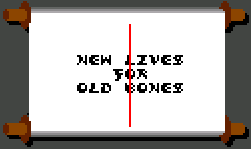
So here is the code of our function:
void CInterface::drawTextMultiLines(QImage* image, CVec2 pos, EFonts font, std::string text, QColor color, int height, int lineHeight)
{
std::vector<std::string> lines = getTextLines(text);
// center the text vertically
if (height != 0)
pos.y += (height - lines.size() * lineHeight) / 2;
// draw each line of text
for (size_t i = 0; i < lines.size(); ++i)
{
CVec2 pos2 = pos;
pos2.x -= lines[i].size() * getCharSpacing(font) / 2;
drawText(image, pos2, font, lines[i].c_str(), color);
pos.y += lineHeight;
}
}
Objects' parameters
Until now, the "items.xml" in the editor only contained the names of the objects.
We will now use the same file as in the game and the objects names will be in a "texts.xml" file - we didn't have one in
the editor.
So these 2 files will work exactly as in the game.
Then we will need to add a "Text" parameter to the scrolls in "items.xml".
<!-- SCROLL -->
<item name="ITEM105">
[...]
<param type="string">Text</param>
</item>
- We have an array that holds the types and names of the parameters: mObjectsParams in CMap
class CMap { [...] std::vector<std::vector<CParamType>> mTilesParams; // list of the params for each type of tile std::vector<std::vector<CParamType>> mWallsParams; // list of the params for each type of wall std::vector<std::vector<CParamType>> mObjectsParams; // list of the params for each type of object [...] }; - The values of the parameters are stored in a mParams array in each CObject:
class CObject { [...] std::vector<CParam*> mParams; [...] }; - I added some utility functions to handle them: findParamByName(), getStringParam(),...
- And obviously the existing CObject functions - load(), save(), etc. - were modified accordingly.
Objects' parameters in the editor
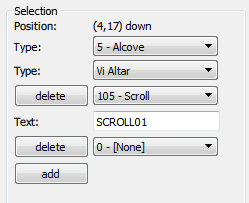
The routine to create these buttons was duplicated for the objects stacks on the ground and in the walls. So I put it
in a new function:
void CEditor::addStackParamsItems(CObjectStack* stack, int startId, QQuickItem* parent, std::vector<QQuickItem *> *list)
{
size_t size = 0;
if (stack != NULL)
{
for (size_t i = 0; i < stack->getSize(); ++i)
{
CObject& obj = stack->getObject(i);
int objType = obj.getType();
addButton(parent, "delete", list, i);
addComboBox(parent, bridge.itemsList, list, startId + i, objType);
if (objType != 0)
{
std::vector<CParamType>& sourceList = map.mObjectsParams[objType - 1];
for (size_t j = 0; j < sourceList.size(); ++j)
{
CParam* param = obj.mParams[j];
if (sourceList[j].mType == eParamString)
{
CParamString* par = (CParamString*)param;
addLabel(parent, sourceList[j].mName + ":", list);
addTextField(parent, QString::fromStdString(par->mValue), list, (j + 1) * 0x10000 + i);
}
}
}
}
size = stack->getSize();
}
addButton(parent, "add", list, size);
}
We will need to retrieve both the index of the object in the stack and the index of the parameter in this object.
So the id has this form:
<parameter index + 1> * 0x10000 + <object index>
void CBridge::setSelParamText(qint32 id, QString value)
{
[...]
if (mTabIndex == eTabTiles)
{
[...]
}
else if (mTabIndex == eTabWalls)
{
CVec2 pos = editor.mSelectStart / TILE_SIZE;
EWallSide side = editor.getWallSideAbs(editor.mSelectStart);
if (id >= 0x10000)
{
CObjectStack* stack = map.findObjectsStack(pos, side);
int objNum = id & 0xFFFF;
int paramNum = (id / 0x10000) - 1;
CObject& obj = stack->getObject(objNum);
CParamType paramInfos = map.mObjectsParams[obj.getType() - 1][paramNum];
if (paramInfos.mType == eParamString)
{
obj.setStringParam(paramInfos.mName, value.toLocal8Bit().constData());
}
}
else
{
[...]
}
}
else if (mTabIndex == eTabObjects)
{
[same code for the stacks on the ground]
}
}
Displaying the scrolls
This is done in the drawScroll() function:
void CInterface::drawScroll(QImage* image, CObject& object)
{
QImage scrollBg = fileCache.getImage("gfx/interface/Scroll.png");
graph2D.drawImage(image, CVec2(80, 85), scrollBg);
if (isPressingEye == true)
{
QImage eye = fileCache.getImage("gfx/interface/Eye.png");
graph2D.drawImage(image, CVec2(83, 90), eye);
}
else
{
QImage arrow = fileCache.getImage("gfx/interface/Arrow.png");
graph2D.drawImage(image, CVec2(83, 90), arrow);
}
std::string text = object.getStringParam("Text");
drawTextMultiLines(image, CVec2(162, 91), eFontScroll, getText(text), SCROLL_TEXT_COLOR, 59, 7);
}
That is because there are two ways to read a scroll:
- Either you put it on the eye in the character's sheet
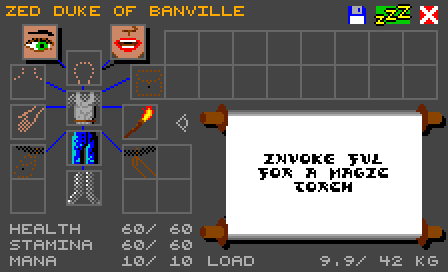
- Or you put it in the character's right hand
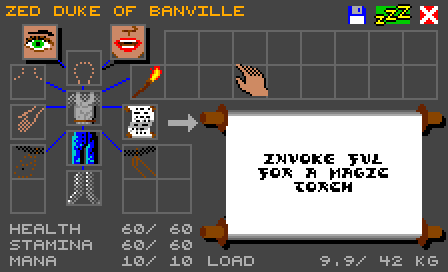
And in the second case, it is called by drawInventory().
In this case, we also need to add a text in drawBodyPart() to display the opened scroll in the hand:
void CInterface::drawBodyPart(QImage* image, CVec2 pos, int championNum, CCharacter::EBodyParts part, bool enableArea)
{
CCharacter* c = &game.characters[championNum];
int objType = c->bodyObjects[part].getType();
if (objType != 0)
{
// draw the object in this slot
CObjects::CObjectInfo object = objects.mObjectInfos[objType - 1];
QImage objImage = fileCache.getImage(object.imageFile.toLocal8Bit().constData());
int imageNum = object.imageNum;
// objects opened in hand
if (part == CCharacter::eBodyPartRightHand)
{
if (objType == OBJECT_TYPE_SCROLL)
imageNum = 30;
}
CRect rect = getItemRect(imageNum);
graph2D.drawImageAtlas(image, pos, objImage, rect);
}
[...]
}
Walls' texts
<wall name="Text">
<image>WallText.png</image>
<param type="string">Text</param>
</wall>
<text id="WALL_TEXT00">HALL OF_CHAMPIONS</text>
<text id="WALL_TEXT01">VI_ALTAR OF_REBIRTH</text>
Note that we only draw it if we are right in front of the wall:
else if (wall->getType() == eWallText)
{
//------------------------------------------------------------------------------
// wall text
std::string text = wall->getStringParam("Text");
text = interface.getText(text);
if (tablePos == CVec2(2, 3) && side == eWallSideUp)
{
interface.drawTextMultiLines(image, CVec2(112, 74), CInterface::eFontWalls, text, QColor(), 0, 11);
}
}
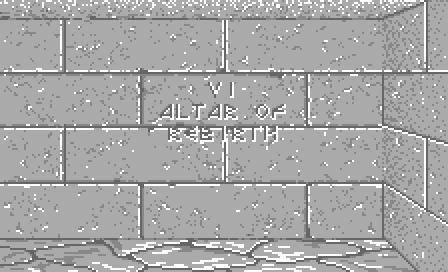
Obviously the wall's graphic is annoying to read the text correcly.
Expecially for the 3rd line.
In the original game there was a trick: a part of the wall was copied over the vertical line between the "bricks".
I did not found an image for that in the original graphics, so I created one myself - it's "TextPatch.png" in
"gfx/3DView".
Once we draw it, this is the result:
else if (wall->getType() == eWallText)
{
[...]
if (tablePos == CVec2(2, 3) && side == eWallSideUp)
{
QImage patch = fileCache.getImage("gfx/3DView/TextPatch.png");
graph2D.drawImage(image, CVec2(111, 97), patch);
interface.drawTextMultiLines(image, CVec2(112, 74), CInterface::eFontWalls, text, QColor(), 0, 11);
}
}
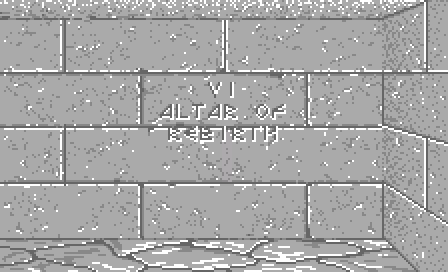
The 3rd line is still a bit misplaced so let's modify drawTextMultiLines() to lower it:
void CInterface::drawTextMultiLines(QImage* image, CVec2 pos, EFonts font, std::string text, QColor color, int height, int lineHeight)
{
[...]
// draw each line of text
for (size_t i = 0; i < lines.size(); ++i)
{
[...]
drawText(image, pos2, font, lines[i].c_str(), color);
pos.y += lineHeight;
if (font == eFontWalls && i == 1)
pos.y += 3;
}
}
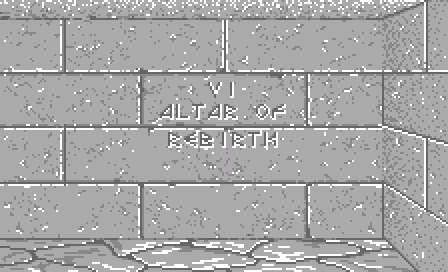
Text ornate
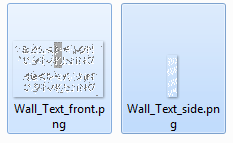
else if (wall->getType() == eWallText)
{
[...]
if (tablePos == CVec2(2, 3) && side == eWallSideUp)
{
[...]
}
else
{
std::vector<std::string> lines = interface.getTextLines(text);
walls.drawOrnate(image, tablePos, side, ORNATE_TEXT, lines.size());
}
}
In the original game, the size of this ornate was based on the number of lines of text.
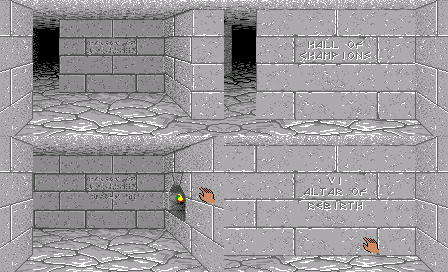
So we will have to modify drawOrnate to achieve this:
CRect CWalls::drawOrnate(QImage* image, CVec2 tablePos, EWallSide side, int ornate, int textLines)
{
if (ornate != 0)
{
[...]
if (gWallsInfos[tablePos.y][tablePos.x][tableSide].size.x != 0)
{
[...]
// calculate the position and scale factor and draw the ornate in a temporary image
float scale = (float)ornateTabData->size.y / 111.0f;
QImage ornateImage = fileCache.getImage(ornateFileName.toLocal8Bit().constData());
if (ornate == ORNATE_TEXT)
{
CRect rect;
rect.tl = CVec2(0, 0);
rect.br.x = ornateImage.width() - 1;
if (side == eWallSideUp)
{
static int heights[] = {0, 14, 27, 41, 55};
rect.br.y = heights[textLines];
}
else
{
static int heights[] = {0, 10, 20, 31, 41};
rect.br.y = heights[textLines];
}
ornateImage = graph2D.cropImage(ornateImage, rect);
}
[...]
QImage CGraphics2D::cropImage(const QImage& srcImage, CRect rect)
{
QRect qrect(rect.tl.x, rect.tl.y, rect.br.x - rect.tl.x + 1, rect.br.y - rect.tl.y + 1);
return srcImage.copy(qrect);
}